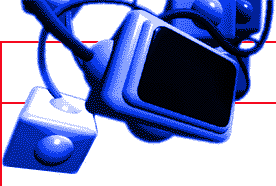Space Station - 2020
Action-Pak
Microgravity
[Do not show to students]
In these experiments, the water and the bottle represent a system. While the bottle is held, only the water is free to fall, so it empties. If the bottle is released, the both the water and the bottle are falling together at the same rate relative to each other, eo the water remains in the bottle. This happens even if the bottle is thrown in the air. A good story dealing with the problems of weightlessness is "The Trouble with Pyecraft" by H. G. Wells
AIMS: To demonstrate in simple form the phenomenon of free fall.
KEY CONCEPTS: All dropped objects are in free fall.
GENERAL: Any object is in free fall when gravity is the only force affecting its motion. Therefore any dropped or thrown object is in a state of free fall. A spacecraft in orbit is also in free fall.
EXPERIMENTS: 1. Find a two-litre pop bottle, and make a hole near the bottom. With your finger over the hole, fill the bottle with water. Remove your finger from the hole - what happens? Why do you think it happens? Fill the bottle again in the same way. This time, drop the bottle. Does the water run out? Why not? What force[s] do you think are acting on the water and the bottle in each stage of the experiment? how does this explain what is happening? Repeat the experiment several times. Can you think of a time when you have experienced what could be called free fall? Describe your feelings.
2. Suspend an object from a spring scale, and note its weight. Drop both together, still attached, and see if you can see what happens. Perhaps you can film this.
3. Make a set of 1/2 - 1 kg weights for your arms and legs, and exercise your arms and legs for about five minutes. Remove the weights, and repeat the exercises. Do they seem easier? Why do you think this is? How would you feel if you could lose the whole weight of your body. What would happen if you wore the weights every day? What do you think would happen to your muscles if you stopped feeling the sensation of weight? Why don't astronauts use weights to work in space.
4. Do a diagram of a human skeleton. Label which bones you think would be most affected by weightlessness. Why is this? Look at the shape of the bones in the hand and foot. Imagine you ahd never seen them before, how could you tell that the foot was designed to carry weight? It used to be thought that large dinosaurs such as Apatosaurus and Brachiosaurus lived in water to support their weight. We now know they walked freely on land, despite their enormous weight [ ~ 100 tonnes ]. What showed that this was the case?
5. The easiest way to simulate weightlessnesss in space is throeugh prolonged bedrest. Longterm patients suffer weakening of the muscles and slight weakening of the bones because they are not working against gravity. Astronauts can actually grow a lttle in space, and this can happen to you after a night's sleep,because you are lying down. Measure yourself accurately before you go to bed, then again as soon as you get up. Are you any taller? What part of your skeleton is compressing to bring you back to your normal height? Why is this, and what purpose does this part normally serve?
6. Astronauts experience "pooling" of their blood in weightlessness, because the heart doesn't have to pump blood up from the legs anymore. There is also a loss of blood volume, which shows up as extra urine production, because less blood is needed. This pooling causes a "stuffed-up" feeling in the head, and a puffy face. To simulate this effect, ask a friend to lie on a board tilted at about 15 degrees, with their feet higher than their heads. Before they lie down, measure their calves, heart rate, and what their face looks like. Ask them to lie on the board for about ten minutes, and compare the measurements with those you took at the start of the experiment.
Because of the lack of stress due to weight, the skeleton has less work to do. It reacts by losing bone desnity. This produces an effect similar to osteoporosis, a disease common in older women, when bone mass is lost, making fractures more likely. You can see what happen to bone when it loses its minerals by performing this exoeriment.
Take a dry, cooked chicken bone, and leave it in a jar of weak acid, like vinegar, for about a week. Examine it after a week, and see what has happened. How could your results help you understand the effects of demineralisation that occurs in weightlessness.
Go to Fact-Pak
Warp to the Teachers' Index Page
|





